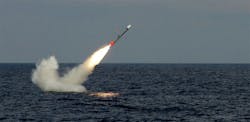Navy asks Raytheon to upgrade and recertify Tomahawk Block IV land-attack cruise missile and guidance system
PATUXENT RIVER NAS, Md. – U.S. Navy guided missile experts are asking Raytheon Technologies Corp. (RTX) to upgrade and recertify version of the BGM-109 Tomahawk land-attack missile to add 15 years of service to the weapon's lifetime.
Officials of the Naval Air Systems Command at Patuxent River Naval Air Station, Md., announced a $287 million order Wednesday to the RTX Raytheon segment in Tucson, Ariz., to provide for recertification and modernization of 166 Tomahawk Block IV missiles -- 142 for the Navy and 24 for U.S. allies. The order includes missile obsolescence and health monitoring, software maintenance, depot support, and hardware procurements.
The Tomahawk Block IV missile is for land-attack missions, and in recent years has been upgraded to attack moving ships at sea. The missile launches from surface warships and submarines. Its users are the U.S. Navy and the United Kingdom Royal Navy.
The RGM/UGM-109E Tomahawk Block IV is one of the latest versions of the 1970s-vintage Tomahawk cruise missile with digital scene matching area correlator system and improved turbofan engine. The subsonic long-range cruise missile is designed to attack targets on land, as well as large hardened surface warships.
Related: Raytheon moves ahead with new guidance sensor and processor for anti-ship Tomahawk missile
The Tomahawk Block IV's guidance system allows for precise targeting over long distances. It combines inertial navigation; Global Positioning System (GPS) satellite navigation; terrain contour matching; and digital scene matching area correlation. Its GPS and gyro-based inertial navigation helps keep the missile on target from long ranges, and its terrain- and scene-matching capabilities use optical sensors to view the ground below to ensure the weapon is on the right path.
The Tomahawk Block IV cruise missile, which can attack targets from as far away as 900 nautical miles, can be controlled in flight, and has a real-time targeting system for striking moving targets. Controllers reprogram the missile in flight to sent it to alternate targets preprogrammed before launch, or redirect it to a new target.
The Tomahawk Block IV missile is capable of launch from surface ships equipped with the vertical launch system (VLS), from submarines equipped with the capsule launch system (CLS), and from submarines equipped with the torpedo tube launch system.
The Tomahawk Block IV has a two-way satellite data link that enables the missile to respond to changing battlefield conditions. The missile can loiter over the battlefield to wait for the most valuable target to attack, and can transmit battle damage indication imagery and missile health, as well as status messages, the weapon's satellite data link. The missile also can fly GPS-only missions.
The Block IV Tomahawk has an anti-jam capability, a 1,000-pound warhead of either high explosives, polymer-bonded explosives, or the BLU-97/B combined effects weapon with independent bomblets designed to cause fragmentation and incendiary damage to enemy fighters, supply depots, and vehicles.
On this contract modification, Raytheon will do the work in Tucson, Ariz.; Pontiac, Mich.; Camden and East Camden, Ark.; Lincoln, Neb.; Clearwater, Fla.; Irvine, Calif.; Keyser, W.Va.; Huntsville, Ala.; Bethel, Conn.; and other U.S. locations, and should be finished by March 2026. For more information contact RTX Raytheon online at www.rtx.com/raytheon, or Naval Air Systems Command at www.navair.navy.mil.
About the Author
John Keller
Editor-in-Chief
John Keller is the Editor-in-Chief, Military & Aerospace Electronics Magazine--provides extensive coverage and analysis of enabling electronics and optoelectronic technologies in military, space and commercial aviation applications. John has been a member of the Military & Aerospace Electronics staff since 1989 and chief editor since 1995.
